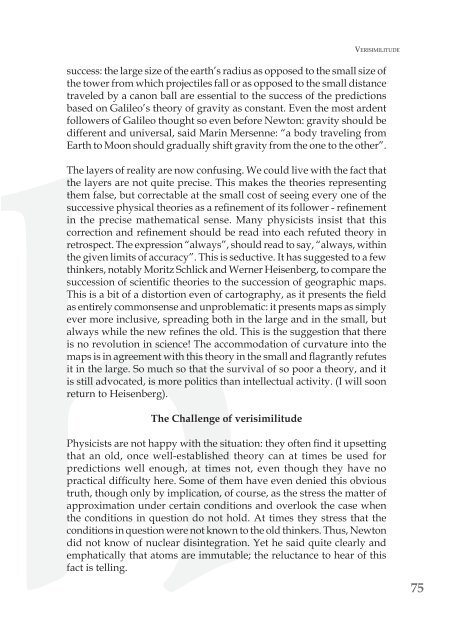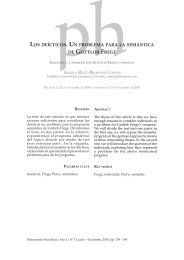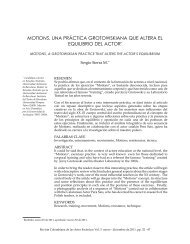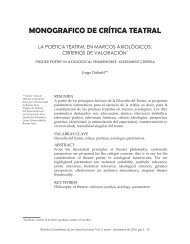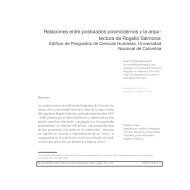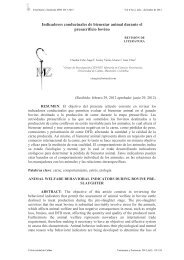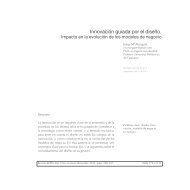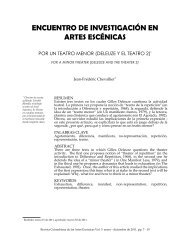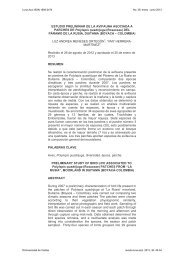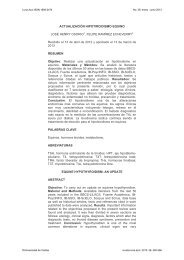Manizales - Colombia Año 12 No. 19 302 p. julio - diciembre 2011 ...
Manizales - Colombia Año 12 No. 19 302 p. julio - diciembre 2011 ...
Manizales - Colombia Año 12 No. 19 302 p. julio - diciembre 2011 ...
You also want an ePaper? Increase the reach of your titles
YUMPU automatically turns print PDFs into web optimized ePapers that Google loves.
VERISImILITuDE<br />
success: the large size of the earth’s radius as opposed to the small size of<br />
the tower from which projectiles fall or as opposed to the small distance<br />
traveled by a canon ball are essential to the success of the predictions<br />
based on Galileo’s theory of gravity as constant. Even the most ardent<br />
followers of Galileo thought so even before Newton: gravity should be<br />
different and universal, said Marin Mersenne: “a body traveling from<br />
Earth to Moon should gradually shift gravity from the one to the other”.<br />
The layers of reality are now confusing. We could live with the fact that<br />
the layers are not quite precise. This makes the theories representing<br />
them false, but correctable at the small cost of seeing every one of the<br />
successive physical theories as a refinement of its follower - refinement<br />
in the precise mathematical sense. Many physicists insist that this<br />
correction and refinement should be read into each refuted theory in<br />
retrospect. The expression “always”, should read to say, “always, within<br />
the given limits of accuracy”. This is seductive. It has suggested to a few<br />
thinkers, notably Moritz Schlick and Werner Heisenberg, to compare the<br />
succession of scientific theories to the succession of geographic maps.<br />
This is a bit of a distortion even of cartography, as it presents the field<br />
as entirely commonsense and unproblematic: it presents maps as simply<br />
ever more inclusive, spreading both in the large and in the small, but<br />
always while the new refines the old. This is the suggestion that there<br />
is no revolution in science! The accommodation of curvature into the<br />
maps is in agreement with this theory in the small and flagrantly refutes<br />
it in the large. So much so that the survival of so poor a theory, and it<br />
is still advocated, is more politics than intellectual activity. (I will soon<br />
return to Heisenberg).<br />
The Challenge of verisimilitude<br />
Physicists are not happy with the situation: they often find it upsetting<br />
that an old, once well-established theory can at times be used for<br />
predictions well enough, at times not, even though they have no<br />
practical difficulty here. Some of them have even denied this obvious<br />
truth, though only by implication, of course, as the stress the matter of<br />
approximation under certain conditions and overlook the case when<br />
the conditions in question do not hold. At times they stress that the<br />
conditions in question were not known to the old thinkers. Thus, Newton<br />
did not know of nuclear disintegration. Yet he said quite clearly and<br />
emphatically that atoms are immutable; the reluctance to hear of this<br />
fact is telling.<br />
75


